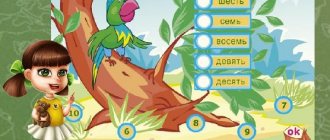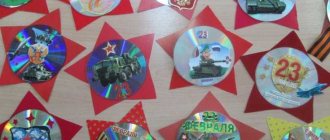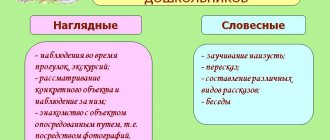The importance of reflection in preschool educational institutions according to the Federal State Educational Standard
According to the Federal State Educational Standard, one of the main tasks of preschool educational institutions is to create the conditions necessary for the comprehensive development of children, according to the specifics of preschool age.
Much attention is paid to supporting children's individuality and initiative, the ability to make decisions in various situations, and expressing their own thoughts and feelings. Based on this, practicing teachers have a need to search for new methods and means of developing conscious activity in preschool children and developing the ability to analyze their own activities. One such method is reflection. The main requirements for preschool teachers are their organization of educational activities with preschool children, demonstrating professionally competent and correct completion of the lesson, using reflective assessment techniques.
Are you an expert in this subject area? We invite you to become the author of the Directory Working Conditions
Definition 1
Reflection is the ability to comprehend and analyze one’s own internal state.
Currently, preschool teachers have accumulated sufficient experience in developing reflective skills in preschool children. Control over the organization of work on the development of reflective skills in children within the preschool educational institution is carried out by a methodologist who evaluates the methods and techniques of reflection selected by teachers, in accordance with the age characteristics of the children.
Note 1
It is advisable to begin the development of reflexive activity skills in preschool children from the second youngest group, that is, with children of the fourth year of life.
Reflection as a means of developing self-esteem in preschool children.
Reflection as a means of developing self-esteem in preschool children.
One of the principles of the modern educational process is the principle of activity, creativity and consciousness. A child can be active if he understands the purpose of learning, its necessity, if his every action is conscious and understandable. A prerequisite for creating a developmental environment in ECD is the stage of reflection.
Reflection
(from the Latin “reflection”) - the ability to reflect, engage in introspection, introspection, comprehension, assessment of the prerequisites, conditions and results of one’s own activities and inner life.
In modern pedagogy, reflection is understood as self-analysis of activities and their results.
The purpose of reflection.
remember, identify and understand the main components of activity - its meaning, types, methods, problems, ways to solve them, results obtained, etc.
Classification of reflection
• REFLECTION OF MOOD AND EMOTIONAL STATE (advisable at the beginning of ECD in order to establish emotional contact, usually during a surprise moment. In order to establish emotional contact with children and at the end of the activity) • REFLECTION OF ACTIVITY (makes it possible to understand the ways and techniques of work in the process of ECD ) • REFLECTION OF THE CONTENT OF EDUCATIONAL MATERIAL (used to identify the level of awareness of the content covered) For reflection to be effective, it is necessary to begin conducting it in younger age groups. Apply reflection of mood and emotional state in GCD and routine moments. Pay special attention to teaching children to be aware of what they are doing and what is happening to them.
You can use the mood corner for this. In the mood corners, children can independently examine animals and people with different facial expressions.
The mood corner helps teach children to understand their emotions and know how to manage them. Children compare their emotions with those depicted in the pictures and attach, for example, clothespins to them that match the color of the depicted mood or photographs of children are attached to them
And also together with the teacher: for example - (look, the red flower is crying - Who cried today when he came to kindergarten? Which flower is in a good mood. And which of the guys is in a good mood. And which flower is laughing? Which guy does he look like, who is laughing today?)
Examples: “REFLECTIONS OF MOOD AND EMOTIONAL STATE”
To determine the mood by color, you can apply Max Luscher's color characteristics
Red rich and bright color -
nervous, excited state, aggression;
Blue -
sad mood, passivity, fatigue;
Green -
activity;
Yellow -
pleasant, calm mood;
Violet -
restless, anxious mood, close to disappointment;
Grey -
isolation, grief;
Black -
sad mood, denial, protest;
Brown -
passivity, anxiety and uncertainty.
“Sun” (children attach rays in red or green, corresponding to his mood) “Sun” - rays according to the number of children, children attach bows according to their mood “Vase with flowers” “Tree with leaves” “Smileys” In older preschool age, you can use three colors (red - nervous, excited state, aggression; green - activity; yellow - pleasant, calm mood), for example, “Mood Tree” “Dress up the Christmas Tree” “Meadow with Butterflies”
Options for depicting reflection depend on the meaning of the lesson (sad bunny, happy bunny; sad fish, happy fish, etc.)
Finish it." Children are given faces and they draw their own mood
REFLECTION OF ACTIVITY
Reflection on activity makes it possible to comprehend the methods and techniques of work. The use of this reflection at the end of the GCD makes it possible to assess the activity of everyone at different stages of the lesson.
“Tree of Success”, where a certain color of leaves indicates the levels of assimilation of material on the GCD (green - if everything worked out, you completed all the tasks; yellow - if it was difficult, but you managed it; red - if it was very difficult and you need help))
Similarly - “Apple Tree” “Target”
“Traffic light” - children hold up cards of a certain color, this allows you to see how clear each stage of the GCD is for children. “Magic bag” Children have cards depicting the stages of GCD. Let's collect in this magic bag all the most interesting things that happened at GCD today.
“Train” On each carriage there is a picture of the stages of GCD, children have emoticons, you can invite children to attach their emoticon to the carriage which type of activity they liked the most.
“Ladder of success” The child must evaluate for himself what step he ended up on as a result of activities during NOD
“Sunny” - I succeeded in everything “Sun with a cloud” - I didn’t succeed in everything “Cloud” - I didn’t succeed in anything
Similarly - “Path of Success”
“Coloring” - children color the sail (yellow, red or green)
“Pantomime” - you can use pantomime to show the result of your work.
For example, hands up - happy with your work, head down - unhappy
REFLECTION OF CONTENT
Reflection on the content of educational material is used to identify the level of awareness of the content covered.
“Reflective circle” (“Microphone”) - children sit in a circle, the teacher asks a question, children in a circle pass each other an object (for example a ball) and answer the questions:
Today I found out... It was interesting... I did it... I remember... Now I can... I was surprised... I didn’t succeed... Children’s statements “I didn’t know...”, “Now I know...”
From all that has been said, we can summarize: reflection is a joint activity of children and the teacher, which makes it possible to improve direct educational activities in older preschool age, focusing on the personality of each child.
Types of reflection used in preschool educational institutions
In the theoretical literature, several types of classifications of reflection are distinguished. In relation to preschool educational institutions, the following classification is more appropriate and acceptable:
Finished works on a similar topic
Coursework Reflection in a preschool educational institution 430 ₽ Abstract Reflection in a preschool educational institution 230 ₽ Test paper Reflection in a preschool educational institution 220 ₽
Receive completed work or specialist advice on your educational project Find out the cost
- Reflection on the content of an educational lesson is aimed at identifying the level of understanding and assimilation by children of the material that was presented by the teacher. Through this type of reflection, the teacher establishes logical connections between acquired knowledge and the ability to use it in practical activities.
- Reflection on pedagogical activity - provides an opportunity to comprehend the techniques and methods of work used by the preschool teacher when organizing training sessions. When conducting this type of reflection, the teacher teaches children to meaningfully control and plan their thinking, their actions, and evaluate their correctness. It is necessary to evaluate only those rules of action that are familiar and understandable to the child.
- Reflection of emotional state and mood - the mood and attitude of students are assessed at the beginning and end of the training session. At the beginning of a training session, reflection helps to identify the children’s emotional mood for the lesson, and at the end, satisfaction from its implementation is revealed.
Master class “Reflective techniques in preschool educational institutions”
Another type of emotional state assessment is the use of nonverbal techniques . Here, every child, without being embarrassed by the opinion of the team, and without fear of condemnation, can safely express his opinion. The main thing is that nonverbal techniques are carried out much faster, more colorful, and more revealing. The use of reflective techniques can begin when children arrive at kindergarten in the morning. To check the emotional state of children I use the following techniques . reflexive techniques are widely reflected in pedagogical practice , that is, the communication technique “Mouth to mouth, eye to eye”
.
The positive aspect of using this kind of technique is lively , relaxed communication, articulating one’s emotions, opinions, and reasoning. The negative point is that not all children will be able to speak out sincerely, for fear of being judged by their peers.
Reflection as a lesson stage: types, techniques, examples
In the structure of a lesson that meets the requirements of the Federal State Educational Standard, reflection is a mandatory stage of the lesson. In the Federal State Educational Standard, special emphasis is placed on reflection of activity; it is proposed to carry out this stage at the end of the lesson. In this case, the teacher plays the role of an organizer, and the main characters are the students. At the beginning of the lesson, emotional reflection is carried out in order to establish contact with the class. You can put on music (choosing a tune that matches the theme), quote a classic, or read out an emotional poem. Afterwards, you should definitely ask 3-4 students: “How do you feel now? What's your mood? Etc. Firstly, students (even the smallest ones) get used to assessing their state, their emotions, and secondly, they learn to argue their point of view. In addition, such reflection will help students tune in to the perception of the topic.
04 Jan 2021 marketur 322
Share this post
- Related Posts
- Who is entitled to benefits from paying traffic police fines?
- The accountant of the education department in rural areas is paid 25% rural?
- Medicine provision for preferential categories of citizens of the Vladimir region
- Who is considered a labor veteran?
Techniques for organizing reflection in children's association classes
Emotional and artistic design. Students are offered two paintings of a landscape. One picture is imbued with a sad, melancholy mood, the other with a joyful, cheerful one. Students choose the picture that matches their mood. You can do it both on a computer and without it, by placing images on the board and voting for them. "Logbook". A form of recording information using keywords, graphic models, short sentences and conclusions, questions. The parts of the “logbook” set by the teacher that will be filled out by students may include: key concepts of the topic, connections that the student can make, important questions.
Various reflection techniques
16) Arrows or graphs on which students depict the result of reflection according to various criteria: understanding, participation in discussion, generating (putting forward) ideas, group interaction, mood, interest in completing the task, ease of completion... - i.e. various types of reflection. Reflection on activity makes it possible to comprehend the ways and techniques of working with educational material and search for the most rational ones. This type of reflective activity is acceptable at the stage of checking homework and defending project work. The use of this type of reflection at the end of the lesson makes it possible to evaluate the activity of everyone at different stages of the lesson, using, for example, the “ladder of success” technique. The effectiveness of solving a given educational task (problem situation) can be presented in the form of a graphic organizer “fish bone”
Reflection techniques in classes in additional education
In the case of using the reflexive technique “Traffic Light”
, the guys raise a card of a certain color, which is an expression of their satisfaction with their work in the lesson. You can also use cards with icons - a question, an ellipsis, an exclamation point, three exclamation points, a colon. It is not difficult to guess what these signs mean (Appendix 2). Many demands are placed on modern occupations today, and the word “reflection” has ceased to be an innovation. An important requirement of modern education is to develop in children the ability to understand the reasons for the success/failure of educational activities and the ability to act constructively even in situations of failure. Almost every teacher of further education today, to one degree or another, uses the technique of reflection in the classroom, often not always clearly understanding what he is measuring and what results he wants to achieve.





